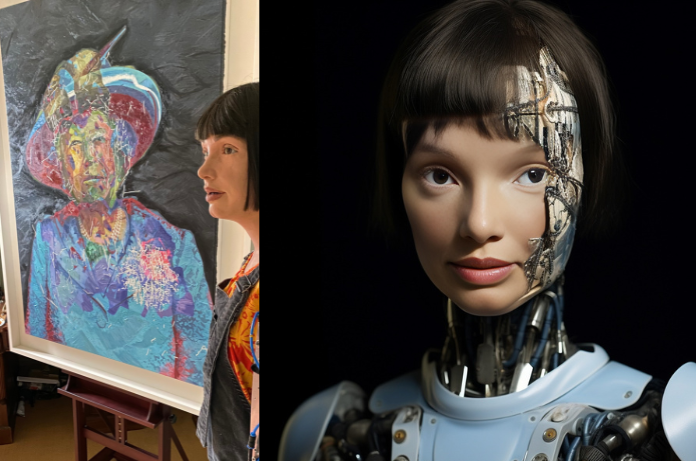A remarkable milestone was set when Ai-Da, the world’s first ultra-realistic robot artist, sold a portrait titled “A.I. God” at auction. The 2.2-meter (7.5-foot) painting of English mathematician Alan Turing sold for an impressive $1,084,800 at Sotheby’s Digital Art Sale, surpassing the pre-sale estimate of $150K.
Ai-Da generates creative ideas through discussions with the studio team. During a conversation on “A.I. for good,” the robot suggested a portrait of Turing. Guided by style, color, and tone, Ai-Da then used its camera-equipped eyes to study an image of Turing and create the artwork.
A Visionary Team of Innovators
On Thursday, at Sotheby’s Digital Art Sale, Ai-Da’s 2.2-meter (7.5-foot) portrait of Alan Turing titled “A.I. God” sold for an astonishing $1,084,800, far exceeding the pre-sale expectations of $180,000. This milestone marks the first time that a humanoid robot’s artwork has been auctioned for such a significant sum, reflecting the growing influence of AI technology in the art world.
The portrait was created by Ai-Da, a humanoid robot with advanced AI capabilities, designed to generate art based on discussions with its studio team. In this case, the concept of Turing’s image emerged during a conversation about “A.I. for good.” Ai-Da’s creators, led by Aidan Meller, an art specialist, and a team of AI experts from the universities of Oxford and Birmingham, guided the robot through the artistic process.
Aidan Meller, an expert in modern and contemporary art, spearheaded the development of Ai-Da alongside AI specialists from Oxford and Birmingham universities. The result is an advanced robot capable of producing unique art and engaging in conversations about its significance and AI’s future.
Turing, known for his role as a WWII codebreaker and an early computing pioneer, had already raised questions about AI’s potential implications in the 1950s. Meller highlighted that the “muted tones and broken facial planes” of Ai-Da’s portrait symbolize the challenges Turing foresaw about AI management.

Art Reflecting Societal Shifts
Described as “ethereal and haunting,” Ai-Da’s work invites contemplation on the role of AI in society. Meller noted that these pieces question the direction of AI development and the global race to control its power. Sotheby’s described the record-breaking sale as a testament to the merging of AI technology with contemporary art.
Can Robots Create Art?
Standing at 2.3 meters tall, A.I. God, a brown-hued portrait of Alan Turing, was crafted by the mechanized hands of Ai-Da, an anthropomorphic robot artist. This groundbreaking artwork garnered significant attention when it was featured for auction by the renowned auction house Sotheby’s, hailed as a historic piece created by a “humanoid robot artist.”
Ai-Da, named after Ada Lovelace, the pioneering 19th-century English mathematician, was developed through the Ai-Da Robot Project in the UK. The project was spearheaded by art specialist Aidan Meller and supported by a team of academics, who equipped Ai-Da with advanced AI technology to enable her unique artistic capabilities.
Ai-Da’s Artistic Philosophy
Ai-Da said, “The key value of my work is its capacity to serve as a catalyst for dialogue about emerging technologies.”The robot elaborated that the portrait of Turing encourages viewers to think about AI’s god-like capabilities and their ethical implications.
Ai-Da is one of the most advanced humanoid robots in existence, designed to resemble a human woman with large eyes, a face, and even a brown wig. Named after Ada Lovelace, the first computer programmer, Ai-Da embodies the merging of human creativity with cutting-edge technology. This design and functionality reflect the ongoing fusion of human artistic expression with the capabilities of AI.
An Ode to Ada Lovelace
Named after Ada Lovelace, the world’s first computer programmer, Ai-Da embodies human-like features such as a face, expressive eyes, and a brown wig, symbolizing the confluence of technology and artistry.
Art for a Technological Age
Meller emphasized that historically, great artists have examined societal changes. “Ai-Da Robot, as technology, is the perfect artist to discuss current developments in technology and its unfolding legacy,” he said.

